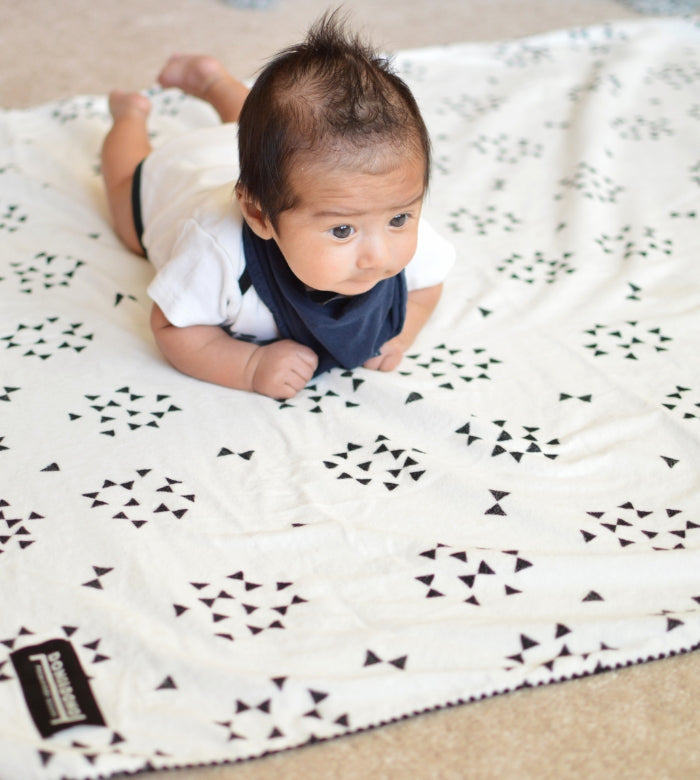As a brand new mom, you might be hearing the phrase “tongue tie” quite a bit now that you have started your breastfeeding journey. Or, if you are about to be a new mom, it will surely be something you start hearing soon. It is a very common condition affecting nearly 5 percent of all newborns. While it can lead to some issues in breastfeeding and later in life, there are ways to start treating it shortly after your baby is born. Keep reading to learn more about tongue tie, symptoms to look out for, and how to treat it.
What is Tongue Tie?
Tongue tie, also known by its fancier, scientific terminology Ankyloglossia, is a condition that a baby is born with that restricts the tongue's range of motion. According to the Mayo Clinic, tongue tie is an unusually short, thick or tight band of tissue (lingual frenulum) that tethers the bottom of the tongue's tip to the floor of the mouth. It may interfere with breastfeeding, and someone who has tongue-tie might have difficulty sticking out his or her tongue. Tongue-tie can also affect the way a child eats, speaks and swallows ( Learn more).
Symptoms of Tongue Tie
The symptoms of tongue tie vary widely. Your baby may have all of these symptoms, none of them, or a combination of some. There are many factors and symptoms that can occur not only in the baby, but in the mother as well, that could point to tongue tie. The best way to diagnose tongue tie is through an appointment with your medical professional.
Symptoms of tongue tie in an infant:
- Difficulty latching and breastfeeding
- Difficulty lifting the tongue up
- Difficulty moving the tongue side to side
- Difficulty sticking the tongue out past the teeth
- A tongue that appears notched or heart-shaped
- Appearance of an obvious string attaching near the top of the underside of the tongue
- Slow weight gain
- Milk dribbles out of the mouth frequently
- Frequent fussing
- Failure to thrive
Symptoms of tongue tie in a mother:
- Painful nursing
- Mastitis or clogged ducts
- Cut, bruised, or flattened nipples
- Poor milk production

If Tongue Tie is Left Untreated
Although tongue tie is most widely regarded as a breastfeeding issue, it can lead to more serious complications down the road if left untreated in your child. Some of these long-term effects include ( link):
- Speech and communication issues, such as speech delay, lisp, or generally difficult to understand
- Eating issues, such as at a very slow pace, picky about textures, and frequently gagging or choking
- Oral hygiene issues, such as teeth gaps, gingivitis, or tooth decay
- Oral activities, such as playing a wind instrument, licking an ice cream cone or popsicle, and licking the lips
- Sleep issues, such as restless sleep, teeth grinding, mouth breathing, and snoring
- Body aches, such as frequent headaches or neck and shoulder pain
Treatments for Tongue Tie
The good news about tongue tie is that it can usually go away without treatment, but in severe cases, it is treatable. If doctors or lactation consultants notice it before a newborn is discharged from the hospital, treatment such as surgery may be offered right away. Other times, a tongue tie is not so obvious and treatment may come at a later time. Speech therapy, surgery, and oral exercises are the most common ways of treating tongue tie.
Speech Therapy
Tongue tie severely impacts the range of motion of a person’s tongue. Difficulty with speech is one of the many side effects that can occur down the road, since the ability to make certain sounds with the tongue is restricted. These sounds include "t," "d," "z," "s," "th," "r" and "l".
If your child is having difficulty creating these sounds when they speak, speech therapy can help them. The earlier the intervention, the better, so that their oral muscles can grow and adjust in the correct places as they grow.

Surgery
One of the most common ways to treat tongue tie is through surgery. There are two procedures to treat tongue tie, known as a Frenotomy and a Frenuloplasty. According to Stanford University ( Article), A Frenotomy is the procedure in which the lingual frenulum is cut. The procedure involves holding the tongue up towards the roof of the mouth to make the frenulum taut, then cutting through the tissue along a line parallel with, and fairly close to, the tongue. The cut is made in a single motion in less than a second, anesthesia is not necessary, and the only risk is excessive bleeding. Normally, there is only a drop of blood or less.
If a tongue tie is too thick for a Frenotomy to be performed, a Frenuloplasty may be recommended. In this procedure, a piece of the frenulum may be removed rather than just simply cut, as in a Frenotomy.

Another way to treat tongue tie is through oral exercises. To prevent ongoing health issues due to tongue tie, an infant can use oral development teethers, such as our line of Innobaby teethers. Oral development teethers will help babies develop healthy oral resting posture, strengthen the jaw, assist with transitioning to foods, and are great self-soothers for those fussy nights — all of which are ongoing side effects of tongue tie.
The Innobaby award-winning teethers are perfect for encouraging proper oral development in your baby. Our teethers were designed with babies in mind. They are:
- Petal-shaped to reach those back molars while stimulating the lips and tongue, especially under the tongue muscles
- Uniquely designed for optimal oral motor exercises
- Multi-textured for sensory stimulation
- Easy & Light for little hands to pick up, hold, grip, and move around
- Durable and safe to use
Innobaby EZ Grip Massaging Star Teether
Dr. Giselle Tadros, DPT at @milkmatterspt highly recommends Innobaby EZ grip massaging teethers as an oral motor development teething toy for all babies. As oral development of a baby impacts the facial structure, teeth, jaw, and mouth shape, she recommends introducing Innobaby’s teether to infants between the ages of 0-3 months to optimize their development progress.
“At early stages, simply hold the teether for your baby as early as 0-3 months to start their oral exercises early. When the baby gets a little older, encourage the baby to hold the teether as it would help develop fine motor skills. Choose a teether that’s lightweight & easy to hold,” says Dr. Tadros. She also has a great tip for tummy time! “While the baby is on their tummy, assist the baby to suckle on the teether for whole-body exercise.”
Innobaby EZ Grip Massaging Star Teether
While designed with babies in mind, they have been manufactured with moms in mind. They’re made with double-injection molding, which means no glues! Since they aren’t heavy or bulky and easy to grasp for the little hands, your little one can explore and use it on their own for tongue/mouth exercises. Not to mention, they are top-rack dishwasher safe and freezer safe to give your baby that extra bit of soothing comfort on their sore gums!






